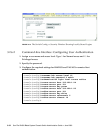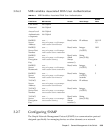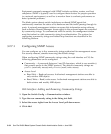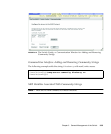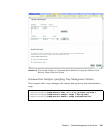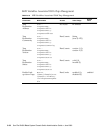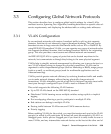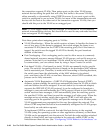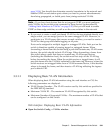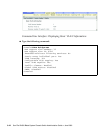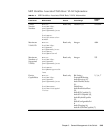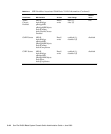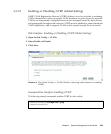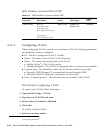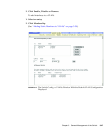
3-40 Sun Fire B1600 Blade System Chassis Switch Administration Guide • June 2003
the connection supports VLANs. Then assign ports on the other VLAN-aware
network devices along the path that will carry this traffic to the same VLAN(s),
either manually or dynamically using GVRP. However, if you want a port on this
switch to participate in one or more VLANs, but none of the intermediate network
devices nor the host at the other end of the connection supports VLANs, then you
should add this port to the VLAN as an untagged port.
Note – VLAN-tagged frames can pass through VLAN-aware or VLAN-unaware
network interconnection devices, but should not be used for any end-node host that
does not support VLAN tagging.
Note these points about assigning ports to VLANs:
■ VLAN Classification – When the switch receives a frame, it classifies the frame in
one of two ways. If the frame is untagged, the switch assigns the frame to an
associated VLAN (based on the PVID of the receiving port). But if the frame is
tagged, the switch uses the tagged VLAN ID to identify the port broadcast
domain of the frame.
■ Port Overlapping – Port overlapping can be used to allow access to commonly
shared network resources among different VLAN groups, such as file servers or
printers. Note that if you implement VLANs which do not overlap, but still need
to communicate, you can connect them by using a Layer-3 router or switch.
■ Port-based VLANs – Port-based (or static) VLANs are manually tied to specific
ports. The switch’s forwarding decision is based on the destination MAC address
and its associated port. Therefore, to make valid forwarding or flooding decisions,
the switch must learn the relationship of the MAC address to its related
port—and thus to the VLAN—at run-time. However, when GVRP is enabled, this
process can be fully automatic.
■ Automatic VLAN Registration – GARP VLAN Registration Protocol (GVRP)
defines a system whereby the switch can automatically learn the VLANs to which
each end station should be assigned. If an end station (or its network adapter)
supports the IEEE 802.1Q VLAN protocol, it can be configured to broadcast a
message to your network indicating the VLAN groups it wants to join. When this
switch receives these messages, it will automatically place the receiving port in
the specified VLANs, and then forward the message to all other ports. When the
message arrives at another switch that supports GVRP, it will also place the
receiving port in the specified VLANs, and pass the message on to all other ports.
VLAN requirements are propagated in this way throughout the network. This
allows GVRP-compliant devices to be automatically configured for VLAN groups
based solely on end-station requests.
To implement GVRP in a network, first add the host devices to the required
VLANs (using the operating system or other application software), so that these
VLANs can be propagated onto the network. For both the edge switches attached
directly to these hosts, and core switches in the network, enable GVRP on the
links between these devices. (See “Configuring VLAN Behavior for Interfaces” on



